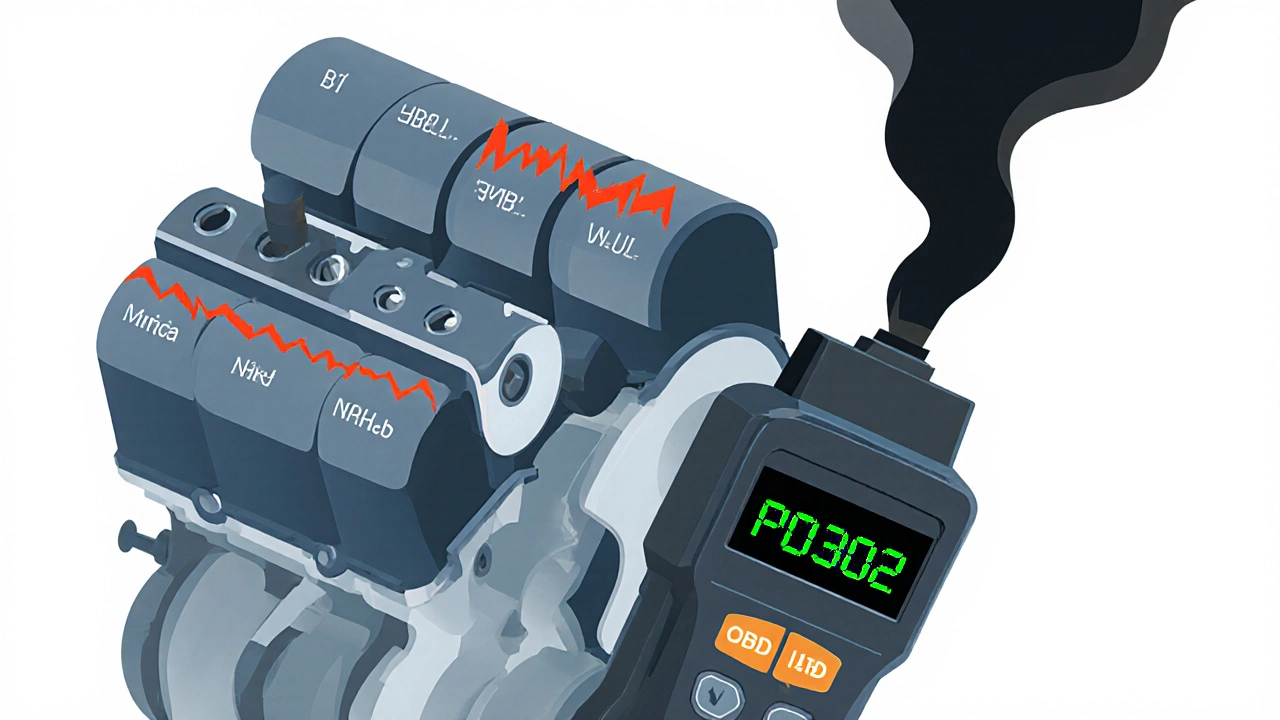Spark Plug Symptom Checker
Check Your Spark Plugs
Select symptoms you're experiencing to get a diagnosis and recommendations for spark plug issues.
When your car starts to cough, stutter, or just won’t finish a mile without a wobble, the culprit is often hiding in the ignition system. spark plug symptoms manifest as a mix of performance hiccups, fuel‑wasting behaviours, and strange noises. Knowing what to look for can save you a pricey repair bill and get you back to smooth driving.
What a Spark Plug Actually Does
Spark Plug is a small but essential component that creates the electric spark needed to ignite the air‑fuel mixture inside each cylinder. By delivering a precise, timed spark, it lets the engine convert fuel into power. When the plug can’t fire correctly, the whole combustion process falters.
Top 7 Symptoms of Bad Spark Plugs
- Engine misfire - one or more cylinders fire unevenly, causing a jerky acceleration.
- Rough idle - the engine shakes or stalls when you’re stopped.
- Reduced fuel economy - you notice the gauge moving faster than usual.
- Hard starting - the engine cranks several times before it finally turns over.
- Loss of power - hills feel steeper, and overtaking becomes a chore.
- Engine knocking or pinging - metallic tapping sounds that echo from the engine bay.
- Excessive exhaust smoke - black or blue smoke may indicate incomplete combustion.
Why Those Symptoms Appear - The Underlying Causes
Each symptom points back to a specific failure mode within the Ignition System. Common causes include:
- Worn electrode tips that can’t generate a strong spark.
- Incorrect spark plug gap - too wide or too narrow.
- Improper heat range for your engine’s operating temperature.
- Fouling from oil, carbon, or fuel residues.
- Faulty Ignition Coil that can’t deliver sufficient voltage.

How to Diagnose Bad Spark Plugs
Before you pull the plug out, run through these quick checks:
- Use an OBD‑II scanner: OBD-II Codes like P0300‑P0306 directly hint at cylinder misfires.
- Listen for a popping or ticking sound during acceleration - a sign the spark is missing.
- Inspect the spark plug visually after removal: black soot indicates a rich mixture; oil film signals wear or valve‑guide leaks.
- Check the spark plug gap with a feeler gauge; the manufacturer’s spec is usually printed on the plug or in the owner’s manual.
Replacing Spark Plugs - Step‑by‑Step Guide
- Gather tools: socket wrench (usually 5/8" or 13mm), spark plug gap gauge, anti‑seize compound, and the correct replacement plugs.
- Let the engine cool for at least 15 minutes to avoid burns.
- Disconnect the battery terminal to prevent accidental sparks.
- Remove the ignition coil or plug wire (depending on your vehicle) by pulling it straight out.
- Use the socket to unscrew the old spark plug. Turn counter‑clockwise until it lifts free.
- Inspect the old plug for fouling, wear, or cracks - note any irregularities.
- If the tip is eroded or the electrode is broken, you’ve confirmed the problem.
- Apply a thin layer of anti‑seize to the new plug’s threads (unless the manufacturer advises otherwise).
- Hand‑tighten the new plug, then give it a final ¼ turn with the torque wrench (usually 13‑20lb‑ft for most cars).
- Reconnect the ignition coil or plug wire, ensuring a snug fit.
- Reconnect the battery, start the engine, and listen for a smooth idle.
If the engine still runs rough, the issue may lie elsewhere - perhaps a clogged fuel injector or a weak fuel pump.

Prevention: Keep Your Spark Plugs Healthy
- Follow the vehicle manufacturer’s replacement interval - typically every 30,000‑60,000km for copper plugs, longer for iridium or platinum.
- Use high‑quality fuel; ethanol‑rich blends can accelerate carbon fouling.
- Regularly change the Air Filter to keep the intake air clean.
- Schedule periodic engine tune‑ups that include ignition system checks.
- Monitor engine temperature; an overheating engine can over‑heat the plugs, causing pre‑ignition.
Quick Reference Table
| Symptom | Likely Cause | Check / Remedy |
|---|---|---|
| Engine misfire | Worn electrode or incorrect gap | Inspect plug tip, measure gap, replace if needed |
| Rough idle | Fouled plug (oil or carbon) | Clean or replace plug, check oil leaks |
| Poor fuel economy | Heat‑range too cold, causing incomplete burn | Verify correct heat rating, replace with spec |
| Hard starting | Weak ignition coil or cracked plug | Test coil voltage, replace coil or plug |
| Engine knocking | Pre‑ignition from overheated plug | Check coolant level, use proper heat‑range plug |
| Excessive exhaust smoke | Incomplete combustion due to fouled plug | Replace fouled plugs, inspect fuel mixture |
Frequently Asked Questions
How often should I replace my spark plugs?
Most manufacturers recommend replacement every 30,000‑60,000km for copper plugs. Iridium or platinum plugs can last up to 100,000km, but always check the vehicle’s service manual.
Can I clean a fouled spark plug instead of replacing it?
A light carbon coating can be cleaned with a wire brush, but oil, fuel, or severe electrode damage requires a new plug. Cleaning is a temporary fix at best.
What’s the difference between copper, iridium, and platinum plugs?
Copper plugs are inexpensive but wear quickly. Platinum and iridium have harder electrode materials, offering longer life and better performance, especially in high‑performance engines.
Why does my car shake only when I’m stopped?
A rough idle is often a sign of a misfiring plug or an incorrect gap. The engine can’t maintain a steady combustion speed at low RPM, causing the shake.
Do spark plugs affect my car’s emissions?
Yes. Incomplete combustion from bad plugs increases unburnt hydrocarbons, leading to higher emissions and potential failure of emissions tests.

